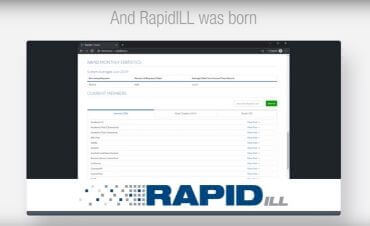As an interlibrary loan system uniquely built around a community of reciprocal users, RapidILL has an outstanding request fulfillment rate of 95% and an average delivery time of less than 12 hours for digital assets.
This is primarily the result of a mutual commitment by every institution in the RapidILL community to 24-hour turnaround times and free-of-charge interlibrary loan transactions. The innovative tools, workflows and technology of RapidILL, now part of the Ex Libris family of solutions, make those transactions seamless, transparent and cost-effective for all participating libraries.

Interlibrary Loan Teams Face Evolving Demands
No library has the ability or budget to own everything, but since the 1960’s, resource sharing has been key to overcoming this limitation. The digital age has greatly increased its importance, with patrons and academic staff able to identify useful local, national and international resources more easily than ever before. While libraries worldwide are struggling with shrinking budgets, physical shelf space and staff sizes, they must also constantly adapt to more complex and dynamic processes. Library staff members are spending a significant amount of time on multi-step processes to review and fulfill patron requests, including determining how and from whom to request the material. They need to check if the item is held locally, locate potential holding libraries, and review lender policies and prices. Often, there is not even an indication of how quickly a lender can fulfill a given request, which complicates service for end-users and creates uncertainty about its timeliness.

An Interlibrary Loan System Revolution
RapidILL, now part of the Ex Libris family of solutions, resolves those issues with a quiet revolution in resource sharing. Developed at Colorado State University by interlibrary loan staff and for interlibrary loan staff, RapidILL provides immediate, simplified, and centralized resource request and delivery through a unique community of reciprocal users. Turnaround times are drastically reduced, while the resource sharing process is seamless, transparent, and cost-effective.


Automated and Streamlined Interlibrary Loan
Every RapidILL member makes service commitments that include fulfilling or responding to lending requests within 24 hours (Monday-Friday) and providing high-quality scanned material. In practice, however, the average turnaround time through RapidILL is less than 12 hours, significantly better than anything customers experienced before joining the RapidILL community. This is the result of several unique RapidILL features that streamline workflows, ensuring fast turnaround times and high-quality fulfillment.
- As part of RapidILL onboarding, a holdings database is created, with a particular focus on journals. As a result, lending staff only receive requests for material their library owns and can lend, significantly reducing the time often spent today in many libraries handling Interlibrary loan requests for resources they do not hold.
- To further simplify lending, requests are automatically sent with the call numbers and locations, making it easy to retrieve the right resource.
- From the borrower’s perspective, the process is completely automated, with no need for mediation. The RapidILL system instantly verifies that a requested resource is not available at the requesting library, nor via open access, and then identifies the lender best able to provide the material within 24 hours.
Each month, RapidILL automatically collates each member library’s resource-sharing statistics, including the number of requests submitted and received, how many were filled, and their turnaround times. Statistics are displayed in table and spreadsheet formats, with granular information down to the article title level. They are also provided in comparison with peer libraries’ system average and can be easily accessed at any time.
Enhanced interlibrary loan system collaboration
Centralized and standardized processes facilitate transmissions and request fulfillment among members of RapidILL library groups, even those using different library management platforms. To bridge the gap between borrowers and lenders using different Interlibrary loan systems for the exchange of journal articles, the solution includes a component called RapidX (at no additional cost) that handles electronic delivery and receipt. Moreover, for the first time, institutions that have no direct bilateral lending arrangements with one another can share resources on agreed-upon terms thanks to RapidILL. Libraries therefore have access to collections that are broader, deeper and of higher quality than ever before. A structure of thematically linked libraries (“pods”), and support for prioritization and tiered configurations ensure each library is working most effectively with its partners to enhance consortial and partner resource sharing. This also means greater exposure for library collections, leveraging them for more extensive peer-to-peer sharing and document delivery.

Seamlessly integrated interlibrary loan system
RapidILL seamlessly integrates into existing library workflows, transparently augmenting interlibrary loan systems and fulfilling requests behind the scenes. Patrons receive their requested material faster, but use the same borrowing and lending management mechanisms they are familiar with (such as ILLiad, Tipasa, RelaisILL, CLIO and Alma). For the library staff, RapidILL is very simple to learn and use. Training is done in two 60-minute online sessions – one for lending and one for borrowing. In addition, as part of the onboarding and set-up process, the current interlibrary loan tools in use are tweaked and a holdings file is created to ensure rapid and seamless workflows.



